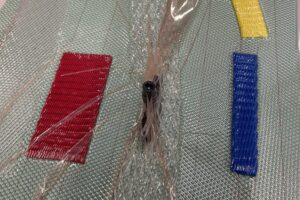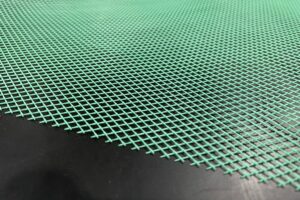Optimize your process and product quality with Bi-planar Mesh Vacuum Resin Infusion Techniques
Comments Off on Optimize your process and product quality with Bi-planar Mesh Vacuum Resin Infusion Techniques Tips to boost your infusion process performance
Tips to boost your infusion process performance
Resin infusion techniques are changing the manufacturing game, offering an effective way to create high quality composite parts.
However, inconsistent mold fill, dry spots, rough surfaces, or excess resin, along with slow cycle times and unnecessary weight can eat into your profits.
There is a solution: a well-executed resin infusion process using bi-planar plastic mesh netting.
Plastic mesh netting is a simple yet powerful tool that ensures the resin spreads evenly, leading to superior parts. The key, is understanding how to control resin flow within the mold using netting.
Let’s break down how plastic mesh netting performs. We’ll share some tips for getting the best results with resin infusion.
What is Resin Infusion Flow Media?
– A simple explanation
Resin infusion flow media, also known as flow channels or infusion mesh netting, acts like a highway for resin to travel through your mold during vacuum infusion.
Its job is to spread the resin evenly across your laminate, making sure there are no dry spots and that all the reinforcing fibres are completely impregnated.
This helps remove trapped air and strengthens your composite materials, resulting in better mechanical properties and a smoother surface finish.
Why choose Bi-planar Plastic Mesh netting?
Extruded Resin Flow Mesh is a diamond-shaped netting that’s designed for smooth resin flow while keeping resin waste to a minimum.
MasterNet’s Bi-planar mesh is a great value option that delivers both speed and efficiency.
There are many types of infusion flow media, but bi-planar plastic mesh netting is a popular choice because it’s so versatile and effective at managing resin flow.
Whether you need tube netting or open mesh designs, our plastic net adapts to complex shapes. This makes it easy to create high-quality parts for everything from aerospace components used in aircraft, to marine structures and boat parts.
It’s lightweight, durable, and a perfect solution for a wide range of composite manufacturing processes.
Key considerations for developing resin flow patterns
Flow Simulation and Analysis
Using flow simulation software allows you to predict your resin flow patterns. It lets you see how the resin will move and spot any potential problems before you start the infusion process.
This helps you fine-tune the placement and configuration of your flow media for optimal results.
It’s where knowledge, creativity, and the right infusion flow media options come together.
Focus on the Resin Infusion Mesh: the Primary flow driver
The way you position bi-planar mesh in the mold can affect how the resin flows.
Bi-planar mesh has strands running in two perpendicular directions, which helps the resin spread in multiple directions. How the mesh is oriented relative to the flow direction and the geometry of the mold, will affect the resin flow behaviour.
Here are 5 important resin infusion factors to consider:
1. Alignment with Flow Direction: Placing the mesh parallel to the main flow direction helps the resin move faster and more evenly. Orient the mesh alignment towards more complex harder to fill areas that are further away from the resin entry points.
2. Obstruction to Flow: Placing the mesh perpendicular to the main flow can slow down or obstruct the resin. This is actually helpful in areas with high mesh density or where a smoother surface is desired.
Too fast a flow can negatively impact finished surface quality in higher mesh densities. You’ll definitely want to slow the flow by introduction of an obstruction.
Proper placement of this perpendicular orientation can serve 2 purposes: slow the flow in the resin entry direction and help resin flow in secondary directions, improving overall distribution within the mold.
3. Combination of Orientations: For complex molds, you might use a combination of mesh orientations, using different layers, to direct the resin exactly where it needs to go.
4. Mold Geometry Considerations: The shape of your mold – including corners, angles, and complex shapes – will also influence how the resin flows.
You’ll need to adjust your mesh orientation to match the specific needs of your mold. Mesh orientation can be tailored to create a consistent resin-flow “front”.
5. Using Resin Spiral Tube or Mesh Rope: In addition to the infusion mesh, there are other tools you can use to help control resin flow.
Our resin spiral tube is like a pipe that can push larger amounts of resin into hard-to-reach areas. Mesh rope is another option that offers a range of flow options based on its thickness and porosity.
Both options can be used in combination with other mesh layers to create the necessary flow pattern.
Why Resin Infusion Techniques matter?
Achieving even resin flow is crucial for making high-quality composite parts with resin infusion.
Plastic mesh netting is a versatile tool that gives you the flexibility, performance, and reliability you need to optimize your process. By understanding how resin flow works and using the right resin infusion techniques and materials, you can take your composite manufacturing to the next level.
MasterNet offers bi-planar resin infusion mesh in 350’ rolls at 41” wide, along with a wide variety of flow rope options to suit your needs.
Interested in learning more about our products?
- Protective Cylinder Sleeves
- Protection Nets
- Industrial/Structural Mesh
- Paver Net, Brick Net, and Tile Net

 Tips to boost your infusion process performance
Tips to boost your infusion process performance



